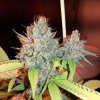You are using an out of date browser. It may not display this or other websites correctly.
You should upgrade or use an alternative browser.
You should upgrade or use an alternative browser.
150w Led Flood Light
- Thread starter ce1esv
- Start date
printer
Well-Known Member
Hi, just joined your thread. Nice plants. I would like to give a little simplification of the led and heat. The Led is a diode (type of semiconductor) that has a junction between two types of material. It needs a certain voltage across it before it starts producing light. It also has a resistance in the material. The resistance just dissipates heat and does not add to the light being produced. As it is heated up the resistance increases. (such as copper wire, has a Positive Temperature Coefficient. "If a material exhibits a positive temperature coefficient means that as its temperature increased its resistance to current raises proportionately."
So the hotter the material, the more resistance it has. The greater the resistance the more power dissipated across it for a given current through it. So if you can keep it cooler there is less resistance and less power wasted just getting through the material. That is why they cool superconductors, to get the resistance down to nothing and the power doing all work with little waste. We are not in the range of superconductors but the cooler we run Leds the light output is a little greater than a hot led.
On inexpensive lights, I use screw in Led lights although I just used the light module and tossed the bulb bit and the screw in part.
So the hotter the material, the more resistance it has. The greater the resistance the more power dissipated across it for a given current through it. So if you can keep it cooler there is less resistance and less power wasted just getting through the material. That is why they cool superconductors, to get the resistance down to nothing and the power doing all work with little waste. We are not in the range of superconductors but the cooler we run Leds the light output is a little greater than a hot led.
On inexpensive lights, I use screw in Led lights although I just used the light module and tossed the bulb bit and the screw in part.
Green Refuge
Well-Known Member
I got the same style lights when I was in Lebanon and Jordan. Worked great and made me think we getting shafted in the United States with these expensive led lights.
printer
Well-Known Member
Memory. It is not the processors slowing things down but bits swapped onto the hard drive.It reminds me of PC processors , people pay more for expensive processors, while there are other alternatives that do the same job for the average user, only a lot cheaper.
Nixs
Well-Known Member
SSDs should help improve things in term if speedMemory. It is not the processors slowing things down but bits swapped onto the hard drive.
printer
Well-Known Member
conventional memory upgrade so it does not have to dump to the HD. But I got too many other things of more importance. When I get too frustrated I fire up two machines.SSDs should help improve things in term if speed
Fred444
Member
Looks goodHi, thanks for the good vibes ... sorry my english
I can grow perfectly with these led projectors, without having to invest so much money.
View attachment 4746826
View attachment 4746827
The pots are 1 liter and there are 21 plants.
Obviously, it is for those who like DIY.
Similar threads
- Replies
- 3
- Views
- 397
- Replies
- 6
- Views
- 475





























